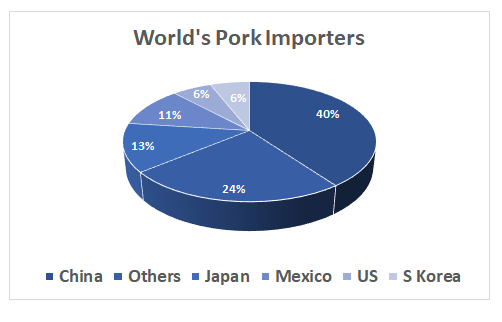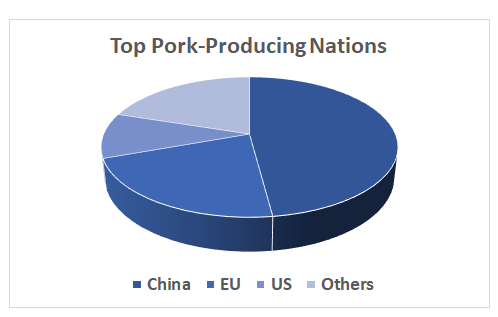Battle to Contain Swine Fever: Wall Street Journal
Battle to Contain Swine Fever: Wall Street Journal

The Wall Street Journal, Sanmen County, China: Last August, a small farm in northern China reported the unexplained deaths of some of its pigs to authorities. Within days, a few dozen hogs tested positive for a deadly and highly contagious virus, and more than 19,000 pigs in the vicinity were slaughtered.
It was the start of the country’s worst outbreak of a livestock disease in decades. Eight months later, African swine fever has swept across China, showing up more than 1,500 miles from the first confirmed cases.
Government data this month showed the disease, and resulting culls, have led to a sharp decline in China’s pig population, which is the world’s largest. The statistics bureau says the country’s hog population has fallen by 40 million from a year earlier, or about 10%, to levels last seen in the late 1990s. “The disease is spreading more quickly than we expected,” said Wantanee Kalpravidh, who works in Asia for the Food and Agriculture Organization, a United Nations agency. Experts see the situation worsening further before it gets better.
The virus is easily transmitted between pigs and via contaminated meat and surfaces. It is a hardy virus that can live for weeks in meat but can also survive and be spread on items like shoes, clothes and vehicles for shorter periods of time. Pigs develop high fevers and lesions, become weak and lethargic, and often die. Some Chinese scientists suggest the virus was brought into the country via smuggled pork offal from Eastern Europe.
While the virus isn’t harmful to humans, the ease with which it has spread in China is raising concern world-wide. There is no cure or vaccination and the only viable response is to cull entire herds once the virus shows up, experts say.
In recent months, customs officials in Japan, Taiwan and Australia have found infected meat in other food products carried by tourists. And the disease has since been confirmed in herds in Vietnam, Mongolia and Cambodia. Matthew Stone, a deputy director general at the World Organization for Animal Health in Paris, said those findings were alarming, and showed there were risks that the disease could become more widespread through the region.

The virus is devastating for China’s pork industry at a time of trade tensions with Washington. Last month importers were forced to pay up for more meat purchases from the U.S. to help satisfy domestic demand, even though last year China raised tariffs on U.S. pork to as much as 70%. Prices of U.S. hog futures have surged nearly 60% since the start of March, partly thanks to Chinese buying.
Many farmers aren’t buying new sows to expand their herds for fear that they may be carrying the disease. A Chinese government official last week predicted prices for pork – the country’s most widely consumed meat – could rise by more than 70% this year.
China’s struggle to contain African swine fever has a lot to do with how pigs are reared in the country. The sector is dominated by millions of farms with fewer than 500 pigs. These animals are often fed kitchen scraps that can contain meat such as raw pork that might be infected with the virus.
Some pig farms are near where corn and other grains are grown for animal feed, making the latter easily contaminated with the virus. Hogs in China are sometimes transported long distances to slaughterhouses located close to where the pork is sold, creating more opportunities for cross-contamination in transit. And many consumers buy fresh pork from open-air stalls or local markets, meaning more people are likely to handle infected meat.
In Sanmen county in eastern China, a region hard hit by swine fever, a dirt road to a once-bustling pig farm is covered in ground lime to stop the spread of the virus. Last October, 56 pigs tested positive for the virus and a total of 3,400 pigs in the area were culled. A three-kilometer (1.86-mile) cordon was marked, and controls were put on people coming and going from the area for six weeks. About 10 miles away, Wu Weiping owns a 4,000-pig farm that was unaffected. “We are worried,” the 61-year-old said. “We were hoping to expand our size, but now we are afraid of importing new sows.”
In a small government office in one of the county’s main administrative centers, a pile of glossy brochures are stacked on a desk. They contain graphic pictures of blackened organs from infected animals and warn farmers against feeding their pigs kitchen refuse. The leaflets also say farmers should report suspicious cases to authorities quickly.
Farmers have been given packets of a white, water-soluble chemical compound for cleaning and disinfecting farms. On one farm, staff use the solution to wash down boots every time they enter the shed, and the farm is cleansed daily. A few miles away at a second, much-smaller operation, the powder is used just once a week to disinfect the premises.
The government pays farmers 1,200 yuan ($179) per culled hog. Some experts say, however, some farms could be reluctant to report sick pigs that could instead be slaughtered and sold for higher prices. In February, China’s Ministry of Agriculture and Rural Affairs chastised and fined two pig-farming companies for not reporting infections in a timely manner and trying to sell pigs at market that hadn’t been quarantined as required.
Even large companies have struggled. WH Group, the world’s largest pork producer and owner of Virginia-based Smithfield Foods Inc., had to close a Chinese slaughterhouse for six weeks after a supplier brought infected pigs to its premises. “Pigs in China are going to be scarce,” said Dr. Kalpravidh at the FAO.
– Lucy Craymer and Zhou Wei
Read more about global pork production from the National Hog Farmer.
Read more about African swine fever from the World Organisation for Animal Health: “African swine fever (ASF) is a highly contagious haemorrhagic viral disease of domestic and wild pigs, which is responsible for serious economic and production losses. It is caused by a large DNA virus of the Asfarviridae family, which also infects ticks of the genus Ornithodoros.”